#���︎盌
Explore tagged Tumblr posts
Text
オンラインストアのkiwahaさんに茶盌を幾つか納品いたしました。ご覧いただけますと嬉しいです。よろしくお願いいたします。
some tea bowls are available at kiwaha online store from July 6.


photos by kiwaha さん
4 notes
·
View notes
Text

お宝増えました。
3 notes
·
View notes
Text
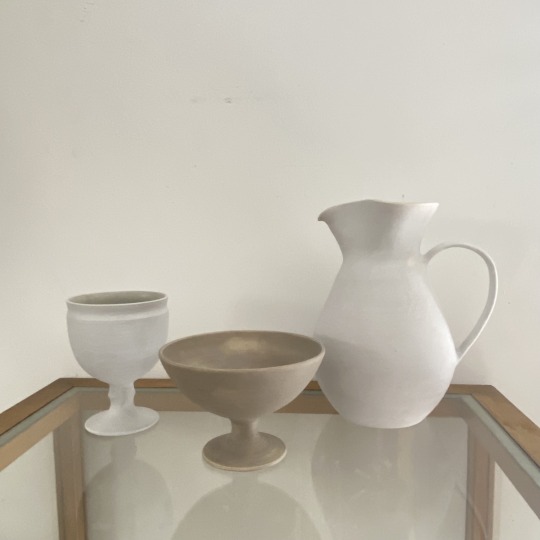
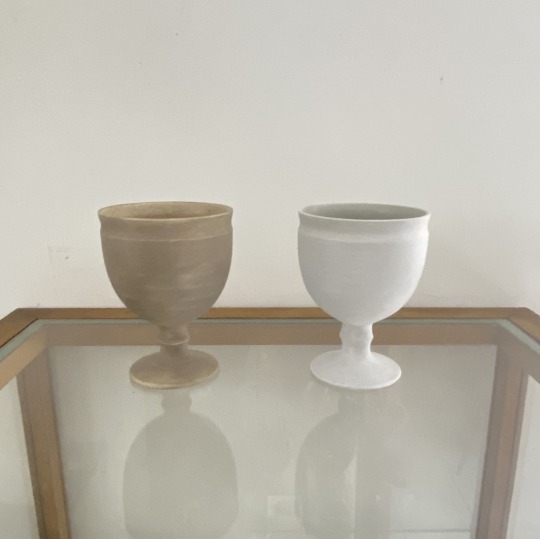

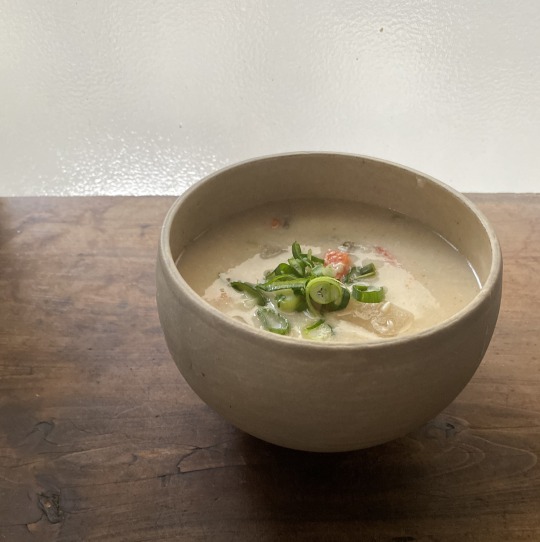
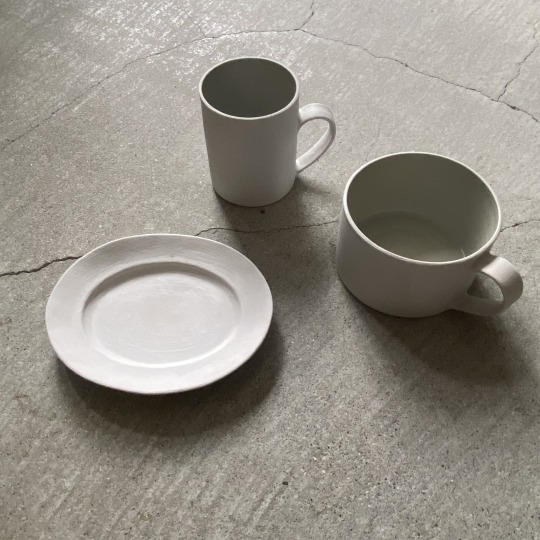

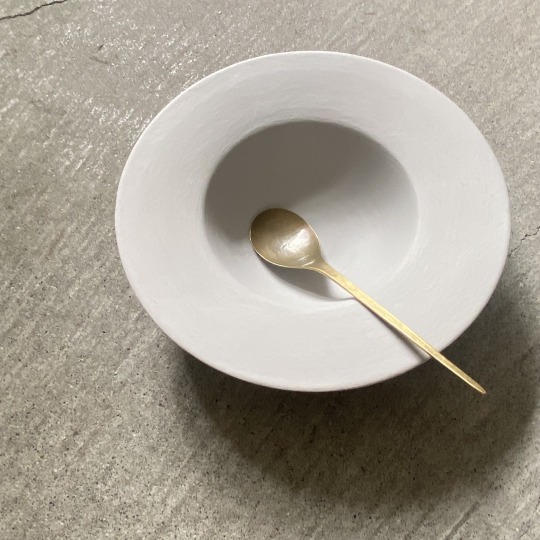
本日もご来店ありがとうございました。お休み明けより新年のご挨拶をしながら皆さんとゆっくりお話しも楽しませて貰いながら、嬉しい時間をいただいています。
昨日に引き続き入荷のご案内です。児玉修治さんより常設分の作品が届いています。今回はデザートカップ、ゴブレット、ジャグ、○盌、ストレートカップW、ストレートカップL、オーバルプレートSS、スープリム皿の8種類です。カンヴァスは全種類ご覧いただけますが、リネンはデザートカップ、ゴブレット、ジャグ、○盌のみになります。お探しだった方は、この機会にぜひ手にして頂けたらと思います。
昨夜は寒い日が続くので粕汁でした。児玉さんの○盌を自宅でも使っていますが汁物や丼、抹茶碗など、使い手のアイデアで多様に楽しんでいただけるのも魅力的です。それぞれ入荷数はたくさんでは無いので、少しずつ楽しんでいただけたらありがたいです。よろしくお願いいたします。
0 notes
Text

A Rare and Unusual Chinese Export Famille-Rose ‘Judgement of Paris’ Punch Bowl
Qing Dynasty, Qianlong Period, Circa 1745
清乾隆 約1745年 粉彩人物故事圖盌
decorated on the exterior with two panels, one depicting the 'Judgement of Paris', the other painted with three Chinese ladies and a boy playing instruments amongst a landscape, the interior with a circular roundel decorated with a European interior depicting three figures. Sotheby's.
Poor Paris. That was a true no-win situation.
5 notes
·
View notes
Text
夜
夜的原野呵,你隐藏着什么?漠上的青冢深掩着出塞的思,娴静的莲蓬怀抱着苦,未老先衰的心里深埋着歌,你呢?草叶铺展着无涯的毯,我的步履,可是再一次繁星般洒落在你的沉默里了。
多少次,我曾以心绪试探你,如露沾湿一口遗忘的盌,枝蔓探入一道荒芜的廊。尘埃里几许淡漠的背影,渗入枕中的小米的香,梦阑放飞着缥缈的筝,醒转又悠悠地飘坠了。
我又有一些疏离的时刻,在昏暗的书页里,无言的窗牖下,四围有人欠伸也恍然心惊。一只小兽纤巧地蹿过,窸窣着消失在路旁的深草,忽又探头作惊异地张望——���也企盼一位不速之客么?你也企盼在相逢的灯影里,不经意说起:“也有过一些黯然的夜”么?
但我终竟是倦厌而放弃了,寂寂的未来,将再不复叩问的脚步,我亦惆怅又淡然地,得到独自的荒凉。深沉的远山漫长地立着,这样的辽阔里,不原也有不可逾越的墙么?风里遥遥的灯火犹疑地明灭,我知晓,那也不过是你垂垂帘幕下透出的点点微光。
Written in 2019
2 notes
·
View notes
Text
6月22日(土)〜30日(日) うつわ菜の花で個展
2024年6月22日(土)〜30日(日)小田原のうつわ菜の花で個展を開催させていただきます。
渡辺愛子さんのやきものを是非見に行ってと、川添微さんに言われて 東武百貨店に行った。ずっと何度も見て来た信楽なのに、初めて見た か の よ う に 、ぐうーっと入ってきた。その信楽茶 盌 を手にしたら、何か 大らかでゆったりとしたものに包まれてすごいなあと感じ入った。この 茶 盌 を手元に置いて、何日もお茶をした。お茶を点てていると、その時 その時によって、その都度新しい魅力があり、新鮮だった。楽しいことである。茶杓師海田曲巷さんとも前から知り合いだったということで、彼にも加わってもらう。——店主・高橋台一さん
会期中の���末、在廊しています。どうぞよろしくお願いいたします。


0 notes
Text
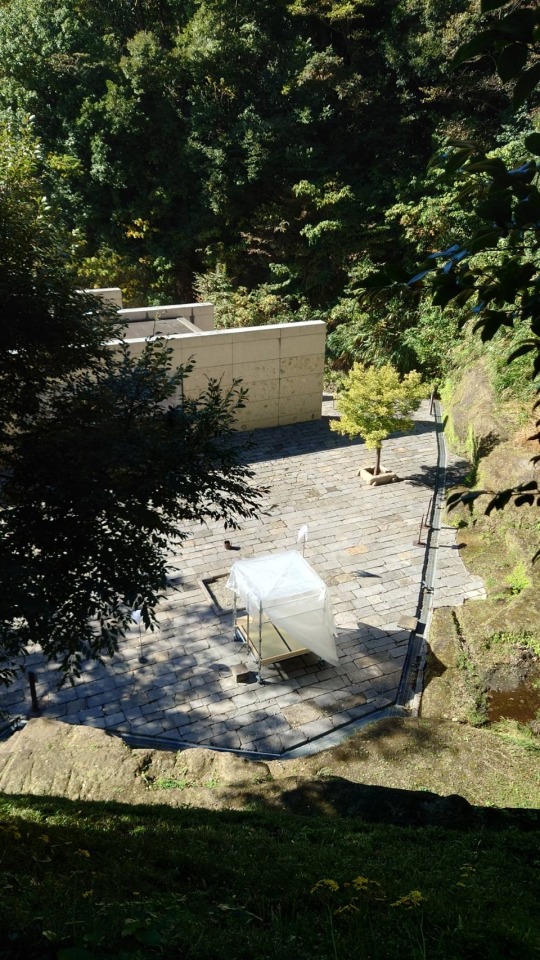
[Exhibition]
Title: ‘flow-an between Foster and Soseki’ Venue: Kamakura Museum of History and Culture (鎌倉歴史文化交流館) Date: 2023.11.1-12.2 10:00-16:00 (Close on Sunday)
主催: 鎌倉歴史文化交流館、ASAL 企画: ASAL 協力: 渡辺育、壺川遠州流禅茶道宗家、by N、米村畳店株式会社 写真提供: KAZUYO by N
鎌倉歴史文化交流館というノーマン・フォスター設計事務所による美術館の中庭に、茶室作品〈浮浪庵〉が展示されています。
鎌倉では、鎌倉時代に五山寿福寺を開山した栄西が源実朝に茶を献上し、その後お茶が流行して日本に茶の文化が広まったという歴史があります。栄西が書いた書「喫茶養生記」(複製)と共に鎌倉で発掘された唐物のお茶盌や、漆皿なども併せて展示しています。
私は今回茶室の置かれる場所がフォスターによる美術館と、鎌倉に特有の中世の〈やぐら〉が遺されている間にある点に着目し「flow-an between Foster and Soseki〈浮浪庵 − フォスターと疎石の間で〉」という文章を併せて寄せています。
会期中には、壺月遠州流禅茶道宗家 四世家元 中村如栴氏、裏千家 黒田 宗雪氏、表千家 SOUTETSU 田中 宗哲氏らによる浮浪庵でのお茶会も催されるようですので、お近くにお越しの際はお立ち寄りください。 予約リンク: https://linktr.ee/artspiritartlife
---
flow-an between Foster and Soseki 〈浮浪庵 - フォスターと疎石の間で〉 2023
この茶室は工事現場で足場として使われる単管材と、農業用の布を組み合わせ、仮設的に作られている。床との接地面には車輪がついており、空間内を自由に移動できる。また、数時間程度で解体可能であり車一台で運べる、文字通り〈浮浪〉する茶室となっている。禅茶や侘茶が「いま・ここ」の宗教性、瞑想性と結びついていたように、この茶室も流れ移ろう都市や自然の中で、ひと時の瞬間を味わう空間として現出する。
知られているように鎌倉歴史文化交流館は、イギリスの巨匠建築家であるノーマン・フォスターの設計事務所による設計であり、茶室が設置される中庭は無量寿院という寺院跡であったと言われている。ここには中世の鎌倉特有の〈やぐら〉が遺されており、それらは夢窓疎石が瑞泉寺にて作り上げた、雪舟の「慧可断臂図」で示されるような禅の岩壁瞑想のための庭園を喚起させる。ここでは仮にそれを疎石による庭園のようなものと〈見立て〉る。
このような背景を踏まえ、フォスターと疎石(の見立て)の〈間(ま)〉を漂う茶室として、今回の浮浪庵を構想した。それぞれの時間、空間の流れの中で、茶を呑みながら〈無(ヴォイ��)〉に立ち返る零度の瞬間を感じて欲しい。
0 notes
Text
Nampō Roku, Book 7 (64b): Rikyū said: the Chakin is Used when Taking Up the Lid of the Kama (Part 2).

64 [continued]) Though [in the daisu temae] there will be no problem [with discarding the chakin -- since mechanisms exist that make it unnecessary for the host to use the same chakin later when serving usucha¹], in the case of things like the san-shu temae [三種手前] where the chakin is deliberately discarded, [it is important to understand that using two chakin] is specifically done as a way to show respect to the san-shu².
In the sō-an [草菴], too, when a treasured chaire or chawan is brought out (whether [the host is performing] bon-date [盆立], or a temae in the category of fukuro-chawan [袋茶盌 = 袋茶碗]), with respect to this matter of discarding the chakin [after it has been used, and then using a new one the next time the chawan needs to be wiped] as described above for the old temae, [you] should understand that [it is equally appropriate for the chakin] to be deliberately discarded [here, as well]³.

In the case of such treasured utensils, or when something will be displayed as an hitotsu-mono [一ツ物] -- or otherwise featured in like manner -- if we wonder whether the host might be able to suggest serving usucha immediately [during the koicha-temae] on such an occasion: for him to do so would be a grievous error⁴. And, [you] should [also] understand, the same is true regarding the guests’ asking [for usucha to be served during the koicha-temae]⁵.

In general, if we fold up [a chakin] that has not been stitched along the [cut] edges, this represents the shin [眞] situation⁶. If [we are using] a meibutsu temmoku, or the chawan is a treasured piece: these are occasions when things should be done in the shin manner⁷.
When the [cut] edges [of the chakin] are sewn so that it can be used for the sort of wiping that includes wringing out [the chakin], this is [what we call] the sō [草] chakin⁸.
[Unfortunately] there are people who confuse the two⁹.

As an alternative [to discarding the chakin], there is the possibility where two [sō] chakin will be dampened together and then [folded together and] used in that way¹⁰. And also where a dry [chakin] is inserted [between] those two [so that all three are then folded together, and used to dry the chawan as a unit -- wringing and then refolding afterward so this three-ply chakin can be used to wipe the chawan again at the end of the temae]¹¹.

Things like the chakin and chasen should not be trivialized [just because they are inexpensive, and used only once before being discarded]¹². [The host] should pay careful attention to the smallest details of everything [that will be part of chanoyu]¹³.
_________________________
◎ In the second part of this entry, the author continues his interpretation of kama-no-futa toru-koto [釜ノ蓋取ルコト] as meaning that the chakin is discarded on the lid of the kama -- though, linguistically speaking, this argument can simply not be supported. That aside, what is said about using two chakin when wiping a treasured chawan, as well as the assertion that treasured utensils should be handled as little as possible, while not always supported by Rikyū’s teachings or practices, have a venerable history among the time-honored traditions of machi-shū no chanoyu -- and this is most likely why this text was inserted into the Shū-un-an cache of documents.
While this entry consists of a single undifferentiated block of text in the Enkaku-ji, and other, manuscripts, topically it breaks into four or five sections, and this is why I chose to format it as I have done above -- since approaching the translation in this way will make the meaning clearer for the reader.
¹The first part concluded with the words: “[w]ith respect to this question of [placing] the [used] chakin [on the lid of the kama], throughout the entire [canon of] daisu [temae], in situations where usucha will not be prepared afterward [during the same temae], or when [the host] understands that a [different] usuchawan should be prepared separately in the katte [with a new chakin arranged in it] so it can be brought out later, there will be no problem with discarding the [used] chakin [in this way].”
What the author is doing here is reminding the reader that, while throughout the established canon of the daisu-temae* there were specific arguments or mechanisms that made it unnecessary for the host to preserve the chakin used when he is preparing koicha so it could also be used to wipe the chawan during the usucha part of the koicha-temae†, the principal reason that the first chakin is discarded and a second, new, chakin is used when it is time to wipe the temmoku the second time (at the end of the temae) was to show respect to the special utensils employed in the san-shu temae‡. ___________ *Which, of course, had only come to be established in the formal, hierarchical system that persists to this day.
This series of roughly 10 or 12 core temae can be contrasted with Rikyū’s seven temae (or, technically, eight -- when the san-shu temae is included) series, which only runss through the same series of variations that he described for use in every other setting (from the ko-ita furo and the different types of irori, through the mizusashi-dana, fukuro-dana, and naga-ita/tana-ita). In other words, for Rikyū, the daisu did not represent something inherently different from the arrangements used in other settings (both in the small room and in the 4.5-mat shoin), but simply the form best suited to the service of tea in the really large shoin, where any of the “lower” arrangements would be visually much less imposing.
Here, in contrast to his understanding, the daisu-temae originally had no real counterparts in the wabi-cha sphere -- though there were persistent efforts on the part of the machi-shū to bring as many aspects of the daisu-temae into the small room as possible -- so that their precious utensils could be showcased in this more intimate (and more commonly used) setting. The rules governing chanoyu in the shoin had become so overwhelming that it was difficult for most people to conduct an ordinary chakai in that kind of venue comfortably.
†The inclusion of usucha during the koicha-temae was actually a feature of Rikyū’s wabi-no-chanoyu, intended for use in the small room.
In the case of the daisu, this kind of thing was generally not done -- and would be precluded by the preparation of a separate suite of usucha utensils in the katte that would be used to serve usucha later -- either after the fire in the furo had been rebuilt or, alternatively, with the whole gathering being moved to a second venue (such as the adjoining kusari-no-ma) for usucha.
‡It is not clear that the author of this entry, or his machi-shū contemporaries who were performing this kind of temae, actually realized that the utensils used during the san-shu temae were supposed to be very specific things.
By this point in the Edo period, virtually any three high-quality utensils could be used in this way, since the primary purpose of the temae was to serve tea to a guest of very high status (so the host would use pieces that would appeal to that guest). By honoring the utensils, the host was doing honor to the guest who would be served from them.
²Sare-domo san-shu nado ha wazato chakin wo sutsuru wo san-shu no shōgan to su, samonaki-toki naru-beki kagiri ha, chakin ni te kama-no-futa toru-koto ha ikenai-koto nari to Kyū no tamau [サレドモ三種ナドハワザト茶巾ヲスツルヲ三種ノ賞翫トス、サモナキ時ナルベキカギリハ、茶巾ニテ釜ノフタトルコトハ不好コト也ト休ノ玉フ].
Sare-domo san-shu nado ha [然れども三種などは]: sare-domo [然れども] means nevertheless, even though, be that as it may, and so forth; san-shu nado ha [三種などは] means with respect to things like the san-shu*.
Wazato chakin wo suteru wo san-shu no shōgan to su [業と茶巾を捨てるを三種の賞玩とす]: wazato [態と] means deliberately, intentionally, on purpose, purposely; chakin wo suteru [茶巾を捨てる]† means to discard the (used) chakin (by placing it on the lid of the kama); san-shu no shōgan to su [三種の賞玩とす] means this is a way of showing respect to the san-shu‡.
This is to say, when the host deliberately discards the chakin (in other words, a second chakin had already, and intentionally, been prepared beforehand), this was always intended as a gesture of respect to the san-shu.
Sa-mo-naki-toki naru-beki kagiri ha [然も無き時なるべき限りは] means on occasions where things are not the same as that -- in other words, on occasions when we are not performing the san-shu temae.
Chakin ni te kama-no-futa toru-koto ha ikenai-koto nari [茶巾にて釜の蓋取ることはいけないことなり] means using the chakin to take up the lid of the kama should not be done**.
It appears that the author’s intended meaning is something like “when it is not the case that a particular deference is being shown to the special utensils, then discarding the first chakin (by placing it on the lid of the kama) and using a second one the next time the chawan needs to be wiped should not be done.” Though, as I discussed in the previous post, how kama-no-futa toru-koto [釜の蓋取ること] can ever be interpreted to mean discarding the chakin on the lid of the kama is linguistically mystifying. Since the meaning of the entry is fairly obvious when taken in toto -- despite these words -- it appears that both Shibayama Fugen and Tanaka Senshō have chosen to simply ignore this point in their commentaries (Shibayama’s comments are limited to an explanation of two phrases, while Tanaka analyzes the entire text line by line while rather shamelessly using this entry to self-promote his annual ko-shiki daisu koshu-kai [古式台子講習会] where, he insinuates, these secret matters will all be revealed).
On a purely practical level, when the chakin is used to handle the lid of the kama the part of the chakin that touches the handle of the lid is the back side, while the front side is what is used to wipe the chawan. But, again, how that would have any connection with this assertion is mystifying. This appears to be a case where Rikyū’s practice differed from what the Sen family preferred to do; and so it followed that Rikyū must be wrong, because the Sen family must be right. This argument is still found to underpin the conclusions of many scholars even today, primarily because the vast majority of scholars who deal with this class of literature are sponsored by one of the modern schools -- meaning that their conclusions must necessarily support the preferences of the school with which they are affiliated -- while anyone else will lack the necessary training and understanding that would allow him or her to arrive at, and give voice to, a conclusion that contradicts with the generally accepted interpretation††.
To Kyū no tamau [と休の給う] means so Rikyū handed down. This phrase grammatically does not seem to have been an original part of the sentence to which it is appended, but appears to have simply been tacked onto the end of an argument that is not only contradictory to Rikyū's original statement (that began this entry), but which also goes against Rikyū's own way of doing things. ___________ *While san-shu originally referred to the three utensils (the Kamakura nasu [鎌倉茄子], the Kazan temmoku [花山天目], and the seiji unryū-mizusashi [青磁雲龍水指]) that the Emperor Go-hanazono [後花園天皇; 1418 ~ 1471] had sent to the shōgun Ashikaga Yoshinori, with the hope that by drinking the tea contained in the chaire he would be able to make a full recovery from his “illness” (Yoshinori, as one of the minor sons of the third shōgun Yoshimitsu, had been trained as a monk since childhood, because he was considered to have no political future; taken from the temple when the fifth shōgun, and his successor the retired fourth shōgun, both died without surviving issue, he appears to have dedicated himself to making up for his decades of abstinence...which naturally took a severe toll on this body); the machi-shū, however, (apparently unaware of the actual history of this name) interpreted san-shu (which means “three objects”) to be a reference to the chaire, chashaku, and temmoku (irrespective of their history or antecedents), the “three objects” that were arranged on the nagabon for the san-shu temae.
†As explained in the sub-note under footnote 15 in the previous post, suteru [捨てる] is the modern version of the archaic (or literary -- which, because of the conservative nature of premodern Japanese, are usually the same) form sutsuru [捨つる] (which is the word used in the entry). Both mean to throw away, to discard.
‡Actually, it only has an effect on the temmoku.
This statement (that using two chakin is done as a gesture of respect) actually misses the point of the action: the chakin not only wipes the chawan clean, but the action is also intended to dry the chawan. This is the important point here because, after doing so, the temmoku will be reinserted into its shifuku -- meaning it must not only be clean, but also as dry as possible (especially important in Japan’s humid climate where mildew -- which would cause the shifuku to deteriorate, as well as impart a bad smell to the chawan that would render it useless -- proliferates easily).
When the temmoku was wiped with the first chakin, at the beginning of the temae, this would make the first chakin wetter than it had originally been, meaning it would be less effective at drying the chawan later in the temae. The second chakin, however, has been sitting, unused and exposed to the air, in the kae-chawan since the beginning of the temae. It will now be dryer than it was originally, meaning that it will be a more effective instrument to accomplish the thorough drying of the temmoku prior to its being inserted into its shifuku.
Whether scientifically accurate or not, this is the kind of thinking that underpinned the original conception of the way the temae was structured. The gokushin temae is purely practical; nothing is done for the sake of “formality” or “show.” What must always be kept in mind is that the gokushin temae was the original temae: the wabi temae of the furo, and the irori, were derived from it by the process of simplification by removing anything that was not necessary. But by the Edo period, because the transmission was achieved through Imai Sōkyū’s machi-shū followers, rather than from the practitioners of the orthodox school (i.e., Rikyū), this process had been forgotten. Therefore, Sōtan’s personal temae (which used the small unryū-gama and the kiji-tsurube) was taken as the basic form of the temae, so that everything “higher” was produced by elaborating on his temae in the same way that the Ogasawara school’s teachings on social etiquette were the result of elaborating upon the usual forms of behavior -- with the sole purpose of abstracting etiquette from ordinary behavior by making it unpredictable (whereupon formal instruction was necessary in order to avoid any mistakes).
**Ikenai [不好 = いけない] means (something) is no good, (something) is wrong; it can also means (something) is useless, that there is no use for (something). The word also includes ideas like must not do, should not do, ought not do; and that a given action is forbidden or prohibited.
Because the Sen family did not use the chakin to protect their fingers, because Sōtan did not do so, it is wrong. End of argument. (Though we must remember that Sōtan's small unryū-gama had a ring handle, and handles of that sort do not get hot enough to make protection necessary.) And when it became absolutely necessary for people to protect their fingers (such as when the handle was made of silver, which can be discolored by the oils in the human fingers), the choice was to use the fukusa.
Traditionally the fukusa was considered ultra pure. It was only supposed to be used to clean the chaire, the chashaku, the chaire-bon, the temmoku-dai, and the ji-ita of the daisu (and so, the corner of the shiki-ita) prior to the chakin’s being placed there. But during the Edo period, it became common to put the fukusa down on the floor, and to use it when handling the lid of the kama (despite the fact that the heat and steam can cause natural dyes to become unfixed, so that they actually cause damage to the lid of the kama -- as can be seen if one inspects the silver handles of lids that have been handled in this way a lot).
The way that the fukusa came to replace the chakin for this purpose can be understood if one looks carefully at the language of chanoyu in the Edo period -- where, as a way to keep their own practices “secret” from the other schools, certain schools came to refer to the fukusa as the chakin (tea-cloth). This is why it is not good idea to mix the various writings of the early Edo period with those that are based on conventions dating from the sixteenth century -- even though many words appear to be the same, the meaning is often deliberately different, and from this statements often appear contradictory when they are, in fact, not.
††My purpose is not to belittle the modern schools, or disparage their scholars, but to expose the logic that underpins most of their arguments. In chanoyu, everyone is free to do as they wish -- obviously, at least if the result of doing things in that way is a good bowl of tea and a satisfying experience for all concerned. Nevertheless, revisionism of this sort is simply wrong: Rikyū said what he said and did what he did, and he left behind sufficient documentary evidence that allows us to understand these things. And if those things were not known to Sōtan or the machi-shū, or if they do not happen to agree with what Sōtan or his descendants (or anyone else) did or said, that can have no bearing on what Rikyū actually said and did. It only means -- as it appears to be -- that the machi-shū tradition has no connection with Rikyū. They are different institutions, and should not be conflated -- at least not if one wishes to come to an understanding of the actual evolution of chanoyu, and the modern system that supports it.
³Sō-an ni te mo, hizō no chaire・chawan nado dete, arui ha bon-date, arui ha fukuro-chawan-tō no temae ni, chakin sutsuru ha migi no kojitsu ni te, wazato sutsuru-koto to kokoro-e-beshi [草菴ニテモ、秘藏ノ茶入・茶盌ナド出テ、或ハ盆立、或ハ袋茶盌等ノ手前ニ、茶巾スツルハ右ノ故實ニテ、ワザト捨ルコトト心得ベシ].
Sō-an ni te mo [草菴にても] means “also in the sō-an....”
Chawan [茶盌] is one of those odd Edo period renderings, the only reason for which seems to be to cause confusion among the uninitiated. Usually chawan [茶碗] is preferred today; Rikyū, however, used chawan [茶椀] (the former meaning a bowl turned from stone; the latter a lacquered wooden bowl -- there is no kanji that actually names a glazed ceramic bowl, since the kanji apparently predated the development of this technology).
Hizō no chaire・chawan nado dete [秘藏の茶入・茶盌など出て] means when a treasured chaire or chawan (or something of the sort) is brought out (for use during the temae).
Arui ha bon-date, arui ha fukuro-chawan-tō no temae ni [或は盆立、あるいは袋茶碗等の手前に]:
◦ bon-date [盆立]* is a temae where the chaire is handled on a tray (the purpose of which is to give some added protection to the chaire by keeping other objects away from it);
◦ fukuro-chawan [袋茶碗] is a temae in which the chawan is tied in a shifuku: sometimes that is the extent of the special treatment (the shifuku means that the chakin and chasen have to be brought out in a kae-chawan, so the special chawan will not be exposed to the temperature shock of cleaning the chasen in cold water at the end of the temae -- or, indeed, to the indignity of being used to clean the dirty chasen), and sometimes the chawan is displayed and handled on a tray, which provides additional protection (in which case the chakin is sometimes placed on the tray until it is discarded).
-Tō no temae ni [等の手前に] means in temae of the same class (as bon-date and fukuro-chawan†) -- that is, temae in which one of the utensils is singled out for special handling, as a gesture of respect.
Chakin suteru ha migi no kojitsu ni te, wazato suteru-koto to kokoro-e-beshi [茶巾捨てるは右の故實にて、態と捨てることと心得べし] means when the chakin is deliberately discarded this should always be a parallel case to what was described previously, with respect to the ancient usage (of the san-shu temae); and the host should understand when and why it is being discarded (by being placed on the lid of the kama).
In the modern bon-date temae, the chakin is placed on the chaire-bon until after the koicha has been drunk. Once it has been used to wipe the chawan following the cleaning of the cha-no-ato [茶の跡], the chakin is placed on the lid of the kama (since it is no longer clean, and so should not be placed on the tray).
In the fukuro-chawan temae, the same basic procedure employed during the san-shu temae is usually followed -- the chakin is placed on the lid of the kama after it has been used to wipe the chawan‡.
In Rikyū’s temae, however, the chakin was used to handle the lid of the kama, and so it was rested on the lid while the chawan was being rinsed for the first time at the beginning of the temae, being returned to the chaire-bon or kae-chawan only after the lid had been closed (which was done to allow the kama to heat fully prior to the preparation of koicha**). It was not “discarded” on the lid (meaning it would remain there until the end of the temae, and never returned to the chaire-bon or kae-chawan) until after the koicha had been drunk††.
Here Shibayama’s text has sō-an ni te mo, hizō no chaire, chawan nado dete, arui ha bon-date mata ha fukuro-chawan no temae-tō ni, chakin sutsuru ha migi no kojitsu ni te, wazato suteru-koto kokoro-e-beshi [草菴ニテモ、秘藏ノ茶入、茶碗抔出、或ヒハ盆立又ハ袋茶碗ノ手前等ニ、茶巾捨ルハ右ノ故實ニテ、ワザト捨ルコト可心得].
The wording is slightly more concise, the punctuation clearer, and, as a result, the meaning is less ambiguous‡‡. But there is no real difference in the meaning, in either Japanese or English, that results from these changes***. __________ *The modern schools prefer to write this name bon-date [盆點 or 盆点] (which they pronounce either bon-date or bon-ten).
Bon-date [盆立] means (the chaire is) standing on a tray -- though tate [立て] is also used to mean prepare tea (so the meaning would simultaneously be “to prepare tea with the chaire [resting] on a tray”). The kanji ten [點, usually simplified to 点 today] means a point or dot, and was used to make the reference seem more mysterious or “philosophical” -- an interesting way of approach the terminology during the Edo period, perhaps (this usage is not seen before then -- though sometimes in earlier works that were transcribed during the Edo period); but Rikyū always preferred to be more literal and direct.
†Both of these temae were originally daisu-temae.
While bon-date had sometimes used in the wabi setting since Jōō’s middle period, the only chawan that is recorded as having been used in a manner that would be consistent with the fukuro-chawan temae was the Shukō-chawan [珠光茶碗] (which, because it was damaged, could only be used in the sō-an/wabi-cha setting). Once this chawan was lost (Nobunaga was using it to serve tea when the Honnō-ji was attacked by Akechi Mitsuhide, and as the chawan was already cracked -- it had been repaired using same-colored lacquer by Jōō -- it was completely destroyed, unlike the two chaire that were recovered and repaired by Enjō-bō Sōen [圓乗坊宗圓; his dates are unknown), no other bowl appears to have been so honored until the Edo period.
‡Today we find several different approaches to this problem:
- In some schools, the chakin is discarded after it has been used once, and a new chakin provided for the second cleaning (in accordance with the text of this entry).
- In some schools two (or even three) chakin are placed one on top of the other and then folded (when two, both are dampened; when three, the middle one is dry, and is there to prevent contamination seeping through and soiling the lower chakin) -- this is sometime called a shin-no-chakin [眞の茶巾] today (this kind of chakin is 1-shaku square and stitched on both ends: it is first folded in half before being folded in thirds in the usual manner -- this should not be confused with the “shin” style of chakin that is referred to in footnote 6) is equivalent to using two regular-sized chakin that are placed one on top of the other: in either case, the chakin is refolded after the first use, so that the bottom chakin is folded on top (therefore providing a completely fresh surface).
- And in other schools, this idea seems to have been forgotten entirely, and just one chakin is used -- though it is wrung out and refolded after the first use, so that the back side is now used when it is time to wipe the chawan the second time.
Irrespective of the approach, the idea is always to wipe the chawan the second time with a clean surface.
**This is an idea that has been generally lost from the modern temae -- an unfortunate result of Sōtan's habituation to the use of the kiji-tsurube. When he was suddenly called upon to use another sort of mizusashi while serving tea to Tokugawa Ieyasu’s granddaughter (the consort of the retired Emperor), he did not know what to do with the chakin (it should have been placed on the shiki-ita; but the large Temmyō kimen-buro, in which the third small unryū gama was used, was placed on a thick, unglazed Korean floor tile with a deeply incised “non-skid” design provided by Furuta Sōshitsu -- this was the original Oribe-kawara [織部瓦], having nothing to do with those Edo-period tiles that were glazed green and white -- and a tile with incised decoration that had been used to pave the courtyard of an administrative building was not a suitably clean surface on which to rest the chakin). So Sōtan improvised by leaving the lid of the kama open during the initial chasen-tōshi (when, originally, it had been closed) -- and since this was tea served in an official setting, once he performed the temae that way it was officially “etched in stone.”
The original thinking was that, though the water used when preparing koicha should be lower in temperature during the furo season than it was during the ro season (because the quality of the tea, harvested in the late spring of the previous year, begins to degenerate once the ambient temperature of the mizuya where the cha-tsubo is stored remains above freezing all day and night), the kama should still be heated fully, since only then can the host intelligently reduce its temperature through the addition of cold water at this time.
If the lid had been left open during the chasen-tōshi, the temperature of the kama will have naturally decreased over time -- though its temperature at any point during that time cannot be predicted with certainty. So, by adding two hishaku of cold water prior to the preparation of koicha, it is likely that the final temperature of the hot water will be too low, which will adversely impact the flavor of the tea (which had already been compromised by the effect of the warm weather on the stored tea leaves). But if the kama is first brought to a full boil (which can only be achieved by closing the lid of the kama fully), then adding two hishaku of cold water (as Rikyū taught) will produce exactly the desired result regardless of the weather on that day, or anything else.
The reason why the modern schools only add one hishaku of cold water at this time is because the lid of the kama had been left open. But the problem with this approach is that adding one hishaku of cold water will have an unpredictable effect on the water temperature -- since there is no way to know precisely what the temperature was prior to the addition of that cold water. As a result, the water used to prepare the koicha might be too hot, or it might be too cold. Adding two hishaku of cold water to a fully boiling kama will always achieve the desired result since the initial temperature of the hot water is not dependent on anything else.
††In the ro season, this would be when the lid of the kama was opened so that hot water cold be added to the cha-no-ato so that the host could drink it (so it would not go to waste). But during the furo season, the chakin was not “discarded” until after the chawan was wiped with the chakin, following its being cleaned after the host drank the cha-no-ato.
‡‡As I have explained before, the text that Shibayama Fugen used as his teihon was transcribed by one of the Enkaku-ji scholars, for his own personal use. Because it was forbidden for anyone to copy anything within the walls of the Enkaku-ji, the process of transcription consisted of that person’s memorizing passages, which he then committed to paper once he arrived outside the temple’s gate. It is in this way that minor changes of the sort noted here (minor changes that both simplify the language, and make the meaning more clear) occurred spontaneously -- since the person could not immediately refer back to the original text (and neither could he take any notes back to the Enkaku-ji the next time he visited in order to verify what he had written).
This text was passed on to Shibayama once the scholar who preparet it came to realize, in his old age, that there was nobody else to whom he could transmit it -- nobody who would subject himself to the strict rules that had governed Nampō Roku scholarship up to that point. If he was not willing to turn a blind eye to Shibayama’s unconventional methods (which included discussing these things with other people who would be even less inclined to keep these matters secret), then he realized that the whole of the Nampō Roku scholarship would die with him (since the documents preserved in the Enkaku-ji would not be sufficient to elucidate matters were the oral traditions -- the many things I am recording in this commentary -- omitted).
Even today, it is not simply enough to pick up a copy of the Nampō Roku, and believe that you will be able to understand what it means without access to information that is not to be found in the entries themselves.
***Tanaka makes the following comments on the sentence discussed in this footnote:
“As I mentioned earlier, this matter of throwing away the chasen is something that is done in the shoin-daisu [setting]; but this is not usually done in the sō-an. When it is a treasured utensil, however, or [something that is displayed as] an hitotsu-mono [一つ物], or things of that sort, there exists the possibility that [the chakin] may be discarded [as described here].
“On such occasions, neither the host nor the guest should propose what later generations have come to call tsuzuki-usucha [續き薄茶].
“In this passage, there is a specific reference to a fukuro-iri temmoku, but Shibayama Junkō-shi [= Shibayama Fugen] once said that when we speak about staging what later generations call chasen-kazari [茶筌飾], this is actually in the same class [of temae] as this fukuro-iri temmoku. This is indeed so! It is, therfore, very strange, when using a chawan that was [originally] displayed in its fukuro, that we [are taught to] put the chasen and chakin back into the chawan at the conclusion [of the temae] when doing something like chawan kazari [茶碗飾]. On such occasions it would make more sense to discard the chasen and chakin[, putting them into a kae-chawan while the chawan itself is returned to its fukuro]. Since this accords with what Rikyū taught[, according to the text of this entry], I feel that Shibayama-shi’s argument makes perfect sense.”
This is a suggestion that modern chajin should consider carefully.
⁴Sayō no hizō-dōgu, hitotsu-mono nado ni kazaritaru ni, sono teishu no aisatsu ni, sugu ni usucha tsukamatsuru-beku nado to iu-koto, dai-naru higa-koto nari [サヤウノ秘藏道具、一ツモノナドニカザリタルニ、其亭主ノ挨拶ニ、スグニウス茶可仕ナドヽ云コト、大ナルヒガコト也].
Sayō no hizō-dōgu [左様の秘藏道具] means treasured utensils like that, treasured utensils of that sort (i.e., pieces suitable for use in the bon-date and fukuro-chawan temae*).
Hitotsu-mono nado ni kazaritaru ni [一ツ物などに飾たるに] means when (one of the utensils) were going to be displayed in the manner of an hitotsu-mono or something of the sort....
Sono teishu no aisatsu ni, sugu ni usucha tsukamatsuru-beku nado to iu-koto [その亭主の挨拶に、直ぐに薄茶仕べくなどと云うこと] means for the host to suggest that he wants to immediately begin serving usucha† (during the same temae -- and presumably using the same treasured utensil)....
Dai-naru higa-koto nari [大なる僻事なり] means this is a gravely serious mistake.
Here we see the assertion that famous or treasured utensils should be used as little as possible -- even when they were the host’s personal possessions. Indeed, it was around this time that the bakufu, having effectively run out of treasures from Hideyoshi’s collection, instituted the rule that when a utensil was bestowed on a person (as a mark of gratitude for some service that he had rendered to the government), it was for the lifetime of the recipient only -- and would have to be returned to the bakufu upon his death. As the loss or damage of the utensil could result in a formal investigation into the affairs of the individual and his administration (whether he was a daimyō in charge of a province, or a businessman overseeing an extended business empire), limiting that utensil’s use was simply prudent -- and this attitude began to ripple out through the tea community at large (as we see here). __________ *By the time this entry was written, the idea that the chaire-bon should be paired with a specific chaire, or how that was to be done, had been forgotten.
Jōō’s large chaire-bon were already being used to serve higashi (this is still true today), while the ko-bon [小盆] (small tray) that had originally been used by Rikyū, were now standardized at 6-sun across -- regardless of the size of the chaire that would be displayed on it. So, by this point in time, bon-chaire was a temae intended to do honor to the chaire (rather than something that was done only when a tray of a suitable size, one that also matched the quality of the precious chaire, was discovered quite by chance); and there was nothing to preclude the same chaire being used without a tray on other occasions when the host felt that doing so was appropriate. (In Rikyū's day, once a chaire had been paired with a tray, it was never supposed to be used apart from that tray: some chajin kept the chaire on the tray even when they were in storage, or when the chaire was being filled with tea in the mizuya.)
Likewise, any treasured chawan could also be so used -- it was during the early Edo period that most respectable utensils were being provided with shifuku; and also during this period that the practice appeared of using a chawan that had been “received” from the shōgun appeared (when someone was served tea in the presence of the shōgun, it was considered offensive for them to return the soiled chawan to the person who was preparing the tea -- only the shōgun himself, or a guest of comparable status, did so -- so the guest was supposed to take the bowl with him -- and such bowls were then said to have been received from the shōgun, and they were used in this way to impress the guests).
†This was, in fact, the way that Rikyū usually did things in the small room. Though while Rikyū's reason was so that the tea remaining in the chaire would not go to waste (since the tea was the most important thing in wabi-no-chanoyu), by this point in the Edo period if usucha was served during the koicha-temae (a possibility that is still considered today in certain specific situations), a separate container of matcha was always provided and used.
⁵Kyaku yori mo aisatsu kokoro-e aru-beshi [客ヨリモ挨拶心得アルベシ].
Kyaku yori mo aisatsu kokoro-e aru-beshi [客よりも挨拶心得あるべし] means the guests should also understand that it is the same for them, regarding making a request (that the host continue by serving usucha during the koicha-temae). That is to say, it is just as wrong for them to ask the host to continue with usucha as it would have been for the host to suggest it.
Because of the extraordinary deference being shown to the chawan or chaire, it is (according to this way of thinking) inappropriate for them to be used any more than what is absolutely unavoidable†. __________ *Furuta Sōshitsu, however, proposed a new way of using the bon-chaire to serve usucha (using the left-over matcha) during the temae. He suggested that, since continually cleaning the chashaku with the fukusa after each bowl of usucha would only make the fukusa so dirty that it would no longer be useful for cleaning anything -- and because it was troublesome, in any case -- that rather than doing so, the chashaku should be placed on the tray so that the scoop-end projected beyond the far rim (making the repeated cleaning unnecessary). Rikyū not only approved of this, but made it a feature of his own bon-date temae.
For Rikyū and Oribe, in the wabi small room, it was the tea that was important. For the chajin of the Edo period, it was the utensils that were important. This is one of the primary differences between their different approaches to chanoyu.
†While in the san-shu gokushin temae, the temmoku was used to prepare only a single portion of koicha (which would be drunk by the person that we would call the shōkyaku, only), by the Edo period, this idea had been expanded to include a single large portion of koicha that would be shared by all of the guests (or at least the upper echelon, when the others would be served from the mizuya). But going beyond that, it was felt inappropriate to use the chawan to also serve usucha (because an individual bowl has to be prepared for each guest).
In contrast, Rikyū taught that, when serving a number of people using an omo-chawan and a kae-chawan, the principal chawan should be used to serve usucha to the shōkyaku, but that the kae-chawan may be used when serving the others, in order to facilitate things (by alternating between the two bowls), so that the gathering would take no more time than necessary (out of consideration for the fire); and the cleaning of the chasen at the end of the temae should always be performed in the kae-chawan.
That said, Rikyū was opposed to performing temae that resembled those used with the daisu in the wabi small room. (And the temae described in this entry definitely resembles the way things were done on the daisu.)
⁶Sōjite hashi-nuwazu ni tatami-taru ga chakin no shin nari [惣テ端ヌハズニタヽミタルガ茶巾ノ眞也].
Sōjite [惣て] means generally speaking, in general, ordinarily, usually.
Hashi nuwazu ni tatami-taru [端縫わずに疊たる]: hashi nuwazu ni [端縫わずに] means (a chakin) with unstitched edges*; tatamu [疊む] means to fold something up, so tatami-taru [疊たる] means to intend to fold up (an unstitched chakin). In other words, a chakin that has been left with unstitched edges with the intention of its being used in just that way.
...Ga chakin no shin nari [...が茶巾の眞なり] means that (kind of chakin) is “shin” [眞].
Because wringing out an unstitched chakin will cause it to begin to fray noticeably on the edges, this is the kind of chakin that was used when the chakin would be used only once and then discarded. ___________ *Hashi [端] means ends or edges. It is referring to the cut ends of the chakin, the place where the 5-sun length was cut from the roll of sarashi [晒] (bleached flax linen).
Because these cut edges fray readily, since an early point (long before chanoyu was brought to Japan, apparently) the edges were rolled slightly and then sewn with a loose stitch that coils around the hem to prevent this fraying.
⁷Meibutsu temmoku, mata ha chawan mo hizō-no-mono ni shin ni subeshi [名物天目、又ハ茶盌モ秘藏ノ物ニ眞ニスベシ].
Meibutsu temmoku, mata ha chawan mo [名物天目、又は茶盌も] means a meibutsu temmoku or a chawan (of the same class or quality)....
Hizō-no-mono ni [秘藏の物に] means for treasured objects (of that sort)....
Shin ni subeshi [眞にすべし] means either “(one ought to) do (things) in the ‘shin‘ manner;” or, “the ‘shin’ (chakin) should be used*.”
This sentence is punctuated differently in Shibayama’s source: meibutsu temmoku mata ha chawan mo, hizō-no-mono ni ha shin ni subeshi [名物天目又ハ茶碗モ、秘藏ノ物ニハ眞ニスベシ]. While the meaning is identical, it is less ambiguous in Shibayama’s version -- as is generally the case. __________ *While the word “shin” [眞] can either mean “formal” or “orthodox” (and these are not necessarily the same in classical writings), at the point in time when this entry was written, the word shin had simply come to be used, in chanoyu, in the same way it is used today. It means neither formal, nor orthodox; it is just the top tier, or “highest class,” of the shin-gyō-sō [眞行草] ternary.
⁸Hashi-nui-shite, shibori-fuku-tame-taru rui ha sō no chakin nari [端ヌイシテ、シボリフクタメタル類ハ草ノ茶巾也].
Hashi-nui-shite [端縫いして] means when the edges have been stitched....
Shibori-fuku-tame-taru rui ha [絞り拭くためたる類は] means this can be used for the sort of wiping that includes wringing out (the chakin).
Sō no chakin nari [草の茶巾なり] means this is the sō [草] chakin.
⁹Tori-chigaete kokoro-eru hito ari [取チガヘテ心得ル人アリ].
Tori-chigaete kokoro-eru hito ari [取り違えて心得る人あり] means there are people who have been misinformed* (the one style of chakin with the other).
In other words, some people think, because the stitched chakin takes more labor or effort to produce, that it must be shin, while the one that has simply been cut off from the roll of sarashi must be sō. But in fact, the opposite is true. __________ *More literally, tori-chigaete kokoro-eru means something like “to know (or believe) something that is mistaken.”
¹⁰Arui ha futatsu chakin mo, futatsu tomo ni shimeshitaru wo mochiiru-koto ari [或ハ二ツ茶巾モ、二ツトモニシメシタルヲ用ルコトアリ].
Arui ha [或は] means alternatively, on the other hand.
Futatsu chakin mo, futatsu tomo ni shimeshitaru wo mochiiru-koto [二つ茶巾も、二つ共に湿したるを用いる] means two chakin, but with the two dampened (and then folded) together, which then are used (as if they were a single chakin) in that way*.
This refers to the case that I mentioned above (in the sub-note “‡” under footnote 2), where two (sō†) chakin are folded together -- so that by wringing them out and then refolding them together after the first use, they may be used again, but with a new chakin now exposed as the wiping surface. __________ *As mentioned in footnote 2, the same result is achieved, in the present day, by cutting a single chakin so it is 1-shaku long (rather than 5-sun as is usual), and then folding this in half once (to produce a rectangle that measures 1-shaku by 5-sun) before it is folded as usual. The school that originated this idea was inspired by this passage.
That said, it is not just that folding two ordinary-sized chakin together results in the same number of layers, but the fact that it is two separate chakin that makes the difference -- according to the way people in the Edo period thought.
†Because they will be wrung out and refolded during the temae. The shin chakin cannot not be wrung out and refolded.
¹¹Arui [ha] futatsu no uchi, kawakitaru wo hitotsu kuwauru-koto mo ari [或二ツノ内、カハキタルヲ一ツ加ルコトモアリ].
Futatsu no uchi, kawakitaru wo hitotsu kuwaeru-koto [二つの内、乾きたるを一つ加えることもあり] means in between the two (damp chakin that were described in the previous footnote) a (third) dry (chakin) is included*.
Arui ha...mo ari [或は...もあり] means this is also a possibility.
Here, following the same kind of logic, while moisture (and so contaminants) can spread easily from one damp cloth to the next, inserting a dry one in between acts as a barrier (more psychological than physical, actually, since the dampness will begin to infiltrate the dry chakin as soon as it is sandwiched between the other two) that prevents this kind of cross-contamination from occurring -- thus, when the stack of three chakin are wrung out and refolded, the one that is now exposed on the surface will be absolutely unused and uncontaminated.
This argument would, of course, would follow logically from the one discussed in the previous footnote.
Nevertheless, it must be said that even two chakin are difficult to fold together without the resulting piece being almost impossible to use. When the number is increased to three, the difficult cannot but increase even further†.
As a final word on this, it is important to point out that this use of multiple chakin was only appropriate when the chawan in question was a special one. It is unclear if, when the host was performing something like kasane-chawan (where a pair of chawan were being used to facilitate the service of tea to a larger group of guests), it would also be suitable on occasions of this sort‡. __________ *The original sarashi [晒] was a long roll of flax linen that was intended to be wrapped around the waist, to support and protect the hara [腹] (the part of the abdomen between the lower end of the rib cage and the mons pubis). As such, it is fairly thick and stiff. This is what Jōō and Rikyū and the chajin of their generation (and their predecessors) had used for chakin.
By the time this entry was written, however, specially made sarashi intended to be cut into chakin was already being produced, and this was much thinner and softer than the other, making the usage described here possible -- at least in theory.
†This is markedly true if the idea is to partly unfold and then drape the chakin over the rim of the chawan prior to wiping it (as the modern schools teach -- a technique that Rikyū employed only when wiping the kae-chawan at the end of the temae).
If the bowl is wiped in Rikyū's way, leaving the chakin folded and using it as a sort of blotter that is moved up from the center in a series of half circles, then at least the action will be possible.
‡While Rikyū would probably have accepted the use of two chakin folded together on such occasions, the modern schools -- in situations when they sanction the use of two chakin -- generally prefer to keep them separate (placing one on the side of the lid of the kama closest to the host, and the other on the opposite side of its handle).
¹²Chakin・chasen nado ha, karogaroshiki-mono to kokoro-e-bekarazu [茶巾・茶筌ナドハ、カロ〰シキモノト心得ベカラズ].
Chakin・chasen nado ha [茶巾・茶筌などは] means things like the chakin and chasen -- things that are inexpensive, and that will be used only for one temae and then discarded.
Karogaroshii-mono to kokoro-e-bekarazu [輕々しい物と心得べからず] means (things of that sort) should not be dismissed as unimportant; (such things) should not be trivialized or taken lightly.
In other words, just because things like the chakin and chasen are inexpensive utilitarian objects that will be used just once, and then discarded, this does not mean we may trivialize them -- think that anything will do, or that the cheapest will suffice, or that we do not need to think about them and their appropriateness to the situation carefully. On the contrary, since these are critically important utensils that are necessary for the preparation of tea -- pieces that, if there is some flaw in them might spoil the tea (and so render the entire gathering pointless) -- we should be no less thoughtful with them than when we are when choosing the precious chawan and chaire, and other utensils, that we will use to serve our guests.
While this is what the passage means, and though this is still an eminently valid assessment of chanoyu (in Japan) today, it is important to mention, once again, how far this idea (that the chawan and chaire should be precious treasures) digressed from Rikyū’s ideal of chanoyu in the wabi small room.
¹³Shisai ni oyobite ha minna nari [子細ニ及テハ一同也].
Shisai ni oyobite ha minna nari [子細に及びては一同なり] means this kind of concern over the smallest details applies to everything (in chanoyu) -- both with regard to the utensils, and to our actions as well.
0 notes
Text
Profile 平井亮汰/Ryota Hirai 陶芸家・美術家。1992年富山県生まれ。大阪産業大学工学研究科環境デザイン専攻。陶によるオブジェや��、インスタレーションを制作する中で、陶芸における歴史や文化的背景、制作工程自体に興味を持ち、近年からはメディウムとしての「陶」ではなく「陶芸」という枠組み全体を扱い、制作、発表を行なう。また、様々な場所に炭を燃料とした小型の窯「埋ミ窯(うずみがま)」を築窯し、滞在制作をするフィールドワーク的活動も行い、その傍ら桃山茶陶からも影響を受け、茶盌や酒器などの器も制作している。 Mail: [email protected] SNS:[Facebook/Instagram]Ryota Hirai ryotahirai.tumblr.com
0 notes
Photo
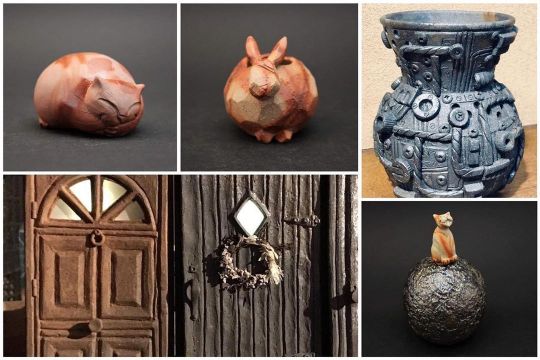
#Repost @bizenmugenanginza ・・・ 備前 細工物展 2023年1月20日(金)〜1月29日(日) 【木曜日休廊】 明日からは 第4回目となります細工物特集のスタートです! 今年も伝統的な宝瓶、香炉、 そして可愛い💕カッコいい🕶 猫さん蛙さんにスチームパンクからドア‼︎まで色々な作品展示させていただきます。 とても楽しい店内になりました♪ 皆様のお出かけ心よりお待ち致しております。 Starting from tomorrow, January 20th, I would like to show our Bizen workmanship of decorated items!! We have some cuties 🐱🐰🐸 with mugs or cups, some cool ones 🐉 with teapots or tea bowls, and steampunks, doors!? and more!! We hope to see you in Ginza⭐︎ ★作品のお問合せは お電話、メール、メッセンジャーにDMなどでも 承れます。どうぞお気軽にお問合せくださいませ。 【2023年の個展・企画展のご案内】 ※2月3日(金)〜2月12日(日) 備前 器 展 ※2月17日(金)〜2月22日(水) #市川透 #金重潤平 二人展 ※3月3日(金)〜3月12日(日) 備前 湯吞展 ※3月17日(金)〜3月22日(水) 備前 #澁田寿昭 陶展 ※3月24日(金)〜3月29日(水) 備前 #豊福博 陶展 #mugenanginza #bizen #vessels #ginza #夢幻庵銀座店 #備前焼 #備前 #柴燒 #銀座 #岡山県 #okayama #pottery #japaneseceramics #備前焼 #徳利#酒呑 #細工物 #宝瓶 #茶盌 #三奈三 #天野智也 #伊勢﨑卓 #内田和彦 #渡邊琢磨 #森脇弘行 #中原幸治 https://www.instagram.com/p/CnoOVvprK2Z/?igshid=NGJjMDIxMWI=
#repost#市川透#金重潤平#澁田寿昭#豊福博#mugenanginza#bizen#vessels#ginza#夢幻庵銀座店#備前焼#備前#柴燒#銀座#岡山県#okayama#pottery#japaneseceramics#徳利#酒呑#細工物#宝瓶#茶盌#三奈三#天野智也#伊勢﨑卓#内田和彦#渡邊琢磨#森脇弘行#中原幸治
0 notes
Text



photos by atelier unieさん
鹿児島のgallery shop アトリエ ユニさん (Instagram @atelierunie_ik )
に花入、花器、酒器、茶盌など納品いたしました。お手に取りご覧いただけますと嬉しいです。
よろしくお願いいたします。
some flower vases, sake cups and tea bowls are available in-gallery shop ( IG @atelierunie_ik )
i hope you can come see them.
7 notes
·
View notes
Photo

グランプリに輝きました! 全ての人に感謝します、 2022年 地球代表 TetsutaroKomago さる1月29日から2月6日まで南青山のギャラリー白白庵で開催されていた、第二回「壺1グランプリ」 Shined in the Grand Prix! Thank you to everyone, 2022 Earth Representative Tetsutaro Komago The 2nd "Vase 1 Grand Prix" was held at Gallery Hakushiroan in Minami Aoyama from January 29th to February 6th. https://www.instagram.com/p/CZqOPuhPP4n/?utm_medium=copy_link #pakupakuan #白白庵 #gp #competition #ceramic #pottery #tsubo #壺 #1 #盌 #bowl #tetsutarokomago https://www.instagram.com/p/CZquRn5lhGP/?utm_medium=tumblr
8 notes
·
View notes
Text

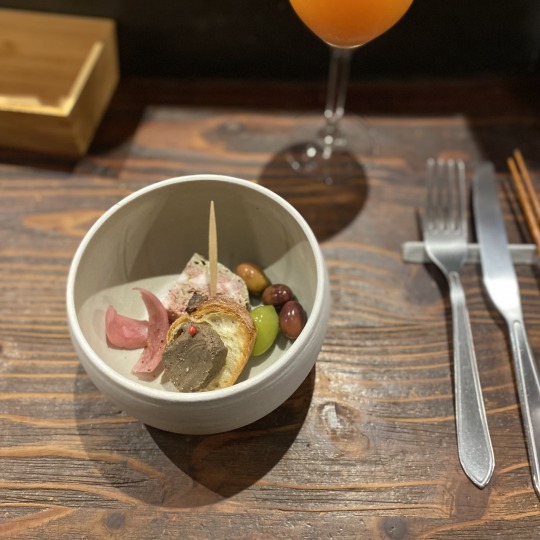

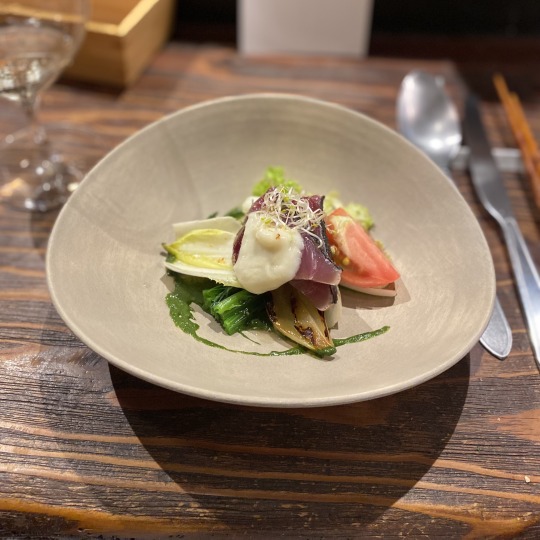
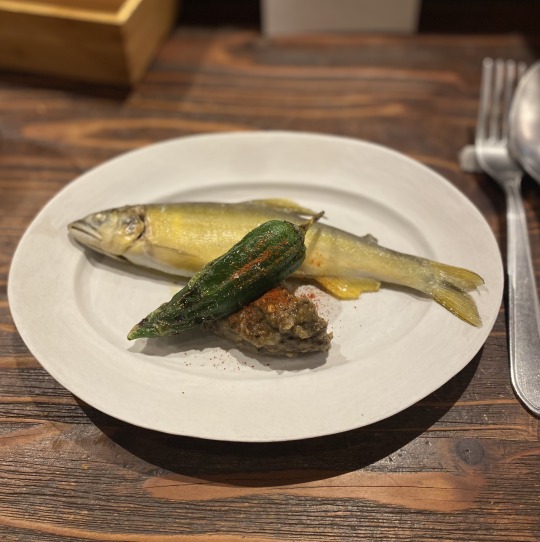
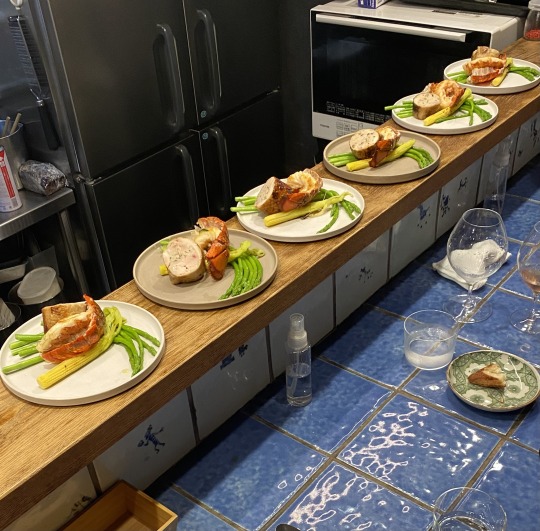
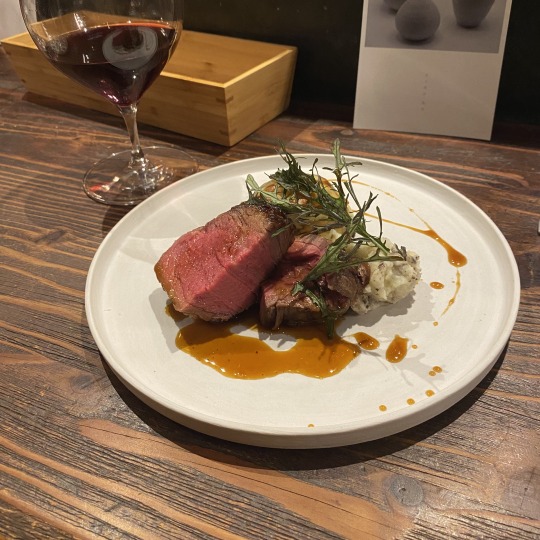
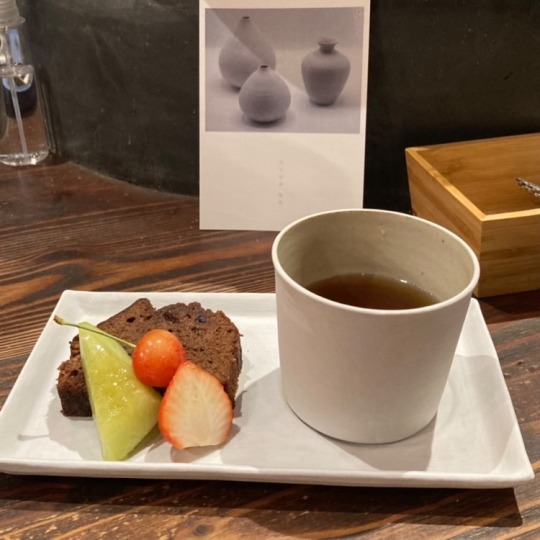


遅くなりましたが・・・「児玉修治 陶展」のイベントとして、在廊してくださる夜に児玉さんの器を使った食事会を開きました。記録も兼ねてまとめてさせて貰います。春に工房へお伺いした際にご相談させていただくと、ぜひ!とこの機会を一緒に楽しんでくださる児玉さんのお陰で、初めての試みでご自身の器を使った食事会を開くことができました。
会場になるお店はhisocaより歩いて5分ほどの御所南にある‘料理・ワイン・イバラキ’さん。お昼のランチの20食限定の中華蕎麦(私は坦々麺推しです!)もとても美味しいのですが、夜はアラカルトでフランス、イタリアの家庭料理や洋食に和の要素をプラスされたワインにあう季節の料理が美味しいお店です。いつも何を食べても美味しいので児玉さんの器に盛られたら?!とイバラキさんとのコラボを思いついてお願いしてみると、6月は春から夏に変わる食材が豊富な時期なのでメニューが色々考えられそうです!と引き受けて下さることになりました。
器のセレクトも茨木さんと一緒にご相談しながら、日々使われる器に食材や盛り付け方で見え方が変わるのを楽しんでいただきたいと日常で手に取りやすいサイズの器を中心に選びました。お料理はセレクトした器を見てひらめかれたものをとメニューは全てお任せすることに。あとはご参加の方が集まってくださるのか受付の日までドキドキでしたが、始まって30分でお席の予約は全て満席になり一つ目の心配がクリアできてホッと。
ここからは当日の様子を。
まずは児玉さんに乾杯のお声かけをいただき、宴はスタート!ブラッドオレンジの食前酒で乾杯。お料理が運ばれてくる毎に、器の誕生秘話などのエピソード、工夫されている点などご説明をいただき以下の7種類のお料理をいただきました。
・前菜盛り合わせ(○盌)まさかのマルワンをスープではなく前菜に使ってくださるとは!最初から予想を超えていく料理と器のコラボにワクワク♪一口アミューズも覗き込む仕様で楽しい演出でした。
・ハモと大葉の生麩とクスクス(デザートカップ)こちらはデザートカップにお寿司に見立て盛り付けられていました。大葉の生麩、焼き霜造りのハモの下に引かれたクスクスにも大葉が使われていて和の薬味が効いた夏らしい爽やかな一品でした。
・鰹のたたきほうれん草のソース(たわみbowl)鰹のたたきをほうれん草のソースで。鰹の下にはほうれん草、新玉ねぎのグリル、チコリやトマトと色合いも華やか。一番上は新玉のソースで、スライスではなくソースにすると鰹との定番の組み合わせも新鮮に。
・鮎のコンフィ(オーバル皿 S)じっくり低温でオイル蒸しされた鮎は骨まで食べれる柔らかさ。添えられた茄子のタプナードと山科とうがらしのグリルがオーバル皿にぴったり収まって美しいかったです。
・ロブスターとチキンのロティ、アメリケーヌソース(ラウンドプレート6寸)カウンター席の方は、茨木さんのご説明を聞きながら器を並べてライブで盛り付けされるのも楽しまれていました!ラウンドプレートはリムがないので6寸でも盛り付け方では十分に楽しめます。この後ソースやディルが添えられて鮮やかに。
・牛ステーキ、賀茂ナスのチーズグリル添え(ラウンドプレート7寸)アンチョビ、マッシュルーム入りのマッシュポテトも添えられていて少しづつ重ねて高さを出されフラットな器に立体的に盛り付けられています。7寸だと一層華やかな印象に。絶妙な焼き加減でお肉も最高に美味しかったです。もうこの時点で眼福で満福!添えられていたパンも食べられないくらいにお腹いっぱいでした。
・チョコレートケーキフルーツ添え(ソーサープレート+そばちょこ)お腹いっぱいなのに一口食べたら止まりません。程よい甘さでペロリといける美味しさでした。児玉さんのお取り扱いが始まった頃によく作って頂いたソーサープレートがデザートがぴったりではと食事会のためにリクエストしました。そばちょこには悠三堂さんの鳳次郎ほうじ茶を。こちらはhisocaよりお持ちいたしました。
こちらの7品に白ワイン2種、ロゼ、赤ワイン2種をペアリングしてくださり、季節感たっぷりな食材と児玉さんの器とのマリ���ージュで大満足な至福の時間となりました〜☆色合いや高さの出し方など真似してみたい盛り付け方もあり、私たちが楽しみやすく緊張せずに楽しめる内容を心がけてくださった茨木さんとスタッフの方にも感謝いたします。(お料理の詳細は、カウンターで茨木さんのお話を伺いながら楽しんでくださったお客様がとても詳しく文章にまとめてらしたので参考にさせて頂きました。ありがとうございます!)
前日は緊張されていると言われていましたが、準備から当日、器のお取り扱いも含めてどっしり構えてご対応くださったので安心してお任せできた茨木さんのお仕事にも感激でした。(当日の写真見直したら、会が始まる前にピースしてらっしゃるくらい落ち着かれてました!)お一人お酒が強くない方がいらっしゃいましたが、こまめにお心配りいただいき最後まで楽しんで下さったご様子でした。ホールにて対応いただきましたスタッフの方にも細やかなお心配りをいただき感謝いたします。またお集まりいただきました皆さまも穏やかで会話を楽しんでくださる方ばかりで、児玉さんご夫妻も含めて終始和やかで笑顔の絶えない楽しい時間に。その様子を拝見できただけでもこの会を計画してよかったと幸せな気持ちになりました。ご参加いただきました皆さまにもありがとうございました。
児玉さんの器は目止めの作業をしてくださっているので、��ンヴァスやリネンなど明るいカラーの器に色の濃いソースや料理を乗せても色移りをしないのもあって今回の食事会を思いつきました。実際に料理が盛り付けられた器たちが生き生きとしている様子をご覧いただけたのも贅沢な機会になりました。お帰りの際には児玉さんよりご参加の皆さまへプレゼントが♪児玉さんがデザインされた手ぬぐいとそれぞれのお席で使われていたカトラリーレストをお土産として頂きました。私も展示の前日まで聞かされていなかったので、児玉さんと奥様も一緒に食事会を楽しんでくださるお気持ちがとても嬉しかったです。児玉さんのてぬぐいはそばちょことセットでの販売を計画されている様です。気になられる方はぜひお楽しみなさって下さい。
児玉さん、茨木さん、今回快く企画に賛同いただき、また最後までお力添えくださり楽しい食事会を終えることができました。心よりありがとうございました。またこの様な楽し良い企画ができるように考えて参りますますので、機会が合いましたら皆さまも是非ご参加よろしくお願いいたします。
1 note
·
View note
Photo

以前、東京広尾のスペース「hakofune」(@tamatehako )で御縁を頂いた、所さん(@saori_1056 )が、お貸しした茶碗をご投稿下さいました🍀 今回は「#一盌からのピースフルネス 」と言うリレーを繋ぐバトンに我が拙作をお使い下さいました。新型コロナで世界が疲弊する中で、人と人とを繋げる重要な役割にお使いいただけた事、大変光栄です!この繋がりが絶えることなく続き、世界平和に辿り着きますことを、心からお祈りしております✨ 所さん、今後ともよろしくお願いします👍 #amazing #art #beautiful #japan #culture #ceramic #ceramics #pottery #madeinjapan #stoneware #matcha #chawan #chanoyu #sadou #zen #禅 #raku #日本文化 #アート #陶芸 #陶器 #茶碗 #茶の湯 #抹茶 #テーブル茶道 #インスタ茶道部 #つたえ手 #伝統工芸 #teaceremony (Tokyo, Japan) https://www.instagram.com/p/CAM9bDyj5zJ/?igshid=bgxku46ce599
#一盌からのピースフルネス#amazing#art#beautiful#japan#culture#ceramic#ceramics#pottery#madeinjapan#stoneware#matcha#chawan#chanoyu#sadou#zen#禅#raku#日本文化#アート#陶芸#陶器#茶碗#茶の湯#抹茶#テーブル茶道#インスタ茶道部#つたえ手#伝統工芸#teaceremony
3 notes
·
View notes
Photo

信樂 烈茶盌 -下溜天羅(カルデラ)- Shigaraki Teared Chawan -caldera- W143×D137 H75mm @2021 ゴツゴツした岩場の 破れた隙間に覗く 翠の湖 飲み干せば底にもまた 蒼く深い海 Rugged rocky area Peek into the torn rocks gap There is Green Lake If you drink it up, also there is a blue deep sea. #wildclay #ichigoichie #hiiro #anagamakiln #shigaraki #teabowl #chawan #yakishime #satokionishi #vidro #naturalashglaze #caldera #woodfiring #tearedchawan #matcha #茶盌 #信楽茶盌 #穴窯 #緋色 #カルデラ #窯変 #大西左朗 #信楽粘土 #カルデラ湖 #ビードロ #一期一会 #窯変 #破れ茶碗 https://www.instagram.com/p/CegcZ8orDjS/?igshid=NGJjMDIxMWI=
#wildclay#ichigoichie#hiiro#anagamakiln#shigaraki#teabowl#chawan#yakishime#satokionishi#vidro#naturalashglaze#caldera#woodfiring#tearedchawan#matcha#茶盌#信楽茶盌#穴窯#緋色#カルデラ#窯変#大西左朗#信楽粘土#カルデラ湖#ビードロ#一期一会#破れ茶碗
1 note
·
View note
